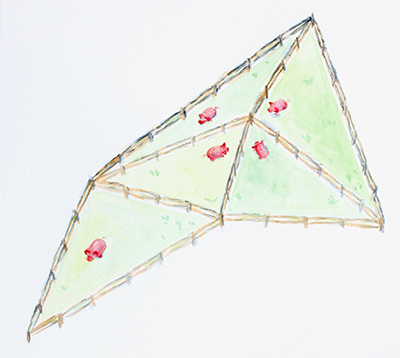
Chapter VII: Triangular pastures (triangulations). (Image courtesy of Talia Blum. Used with permission.)
This chapter is the most algebro-topological part of the course. However, we don’t talk about topological spaces at all, instead keeping to the combinatorial tradition of simplicial complexes (in two dimensions). Arguably, this misses the point entirely, but one can hope that students’ intuition will in some way make up for that. The notion of Betti numbers is easily accessible in the combinatorial context, requiring only some linear algebra, the main drawback being that examples would be more fun with a computer than when done by hand.
Midway through the chapter, we start reaching back to some of the earlier material, not so much in order to use previous theorems, as to take advantage of the visual intuition we’ve built. In that vein, we encounter combinatorial models of the projective plane; and we also introduce loops on abstract complexes, using the previous idea of winding numbers to launch a more general notion. (Experienced readers will notice that this is an ultra-compressed discussion of first homology/cohomology and their pairing.) That final part (Lectures 32-33) is more of a draft, and still needs to mature.
In preparing Lecture 28, I have used S.-W. Cheng, T. Dey, J. Shewchuk, Delaunay mesh generation, CRC Press, 2013, as a reference for Delaunay triangulations. I apologize to all computational geometers for the amateurish notion of “shape complex,” which was vaguely inspired by Edelsbrunner’s alpha complex; see H. Edelsbrunner, A short course in computational geometry and topology, Springer, 2014. Similarly, Lecture 30 is a caricature of G. Carlsson, T. Ishkanov, V. de Silva, A. Zomorodian, On the local behavior of spaces of natural images, Intern. J. of Computer Vision 76 (2008), 1-12. The proof of the evenness of Euler characteristic of an orientable surface was contributed by the sages of the internet: https://mathoverflow.net/questions/310335/closed-orientable-surfaces-have-even-Euler-characteristic.
It’s the kind of “how does one come up with that” argument that I usually avoid, but this one was too pretty to skip.
Lecture 28: Delaunay Triangulations
Lecture 30: Betti Numbers (continued)
Lecture 32: Combinatorial Loops
Lecture 33: Combinatorial Winding Numbers and the Boundary Operators










